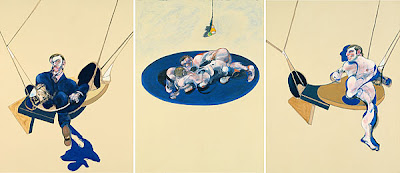 |
| Francis Bacon, Triptych, 1970 Oil on canvas, each 198 × 147.5 cm. National Gallery of Australia, Canberra |
Michael Lloyd & Michael Desmond, European and American Paintings and Sculptures 1870-1970, Australian National Gallery, 1992, p.402: "The features of the man, dapperly dressed in the left canvas, and naked in the right canvas, are recognisably those of George Dyer. Bacon met Dyer in 1964 and he became Bacon’s close friend and primary model for over a decade, his presence persisting in Bacon’s work well beyond his death in Paris in October 1971. Bacon preferred to work from memory and photographs. As a point of departure he often used the serial photographs which Eadweard Muybridge (1830-1904) made in the 1880s of humans and animals in motion and published in the enormous compendium Animal Locomotion in 1887. The image in the central panel of the Canberra painting was adopted from Muybridge’s photographs of wrestlers. Bacon had used this image on a number of previous occasions, at first in Two figures 1953 (private collection, London) and, contemporaneously with the Canberra painting, in the central panel of Triptych — studies from the human body 1970 (collection Jacques Hachuel, Paris). However, Muybridge’s photographs may also have been the source of another feature that is unique to the Canberra Triptych – the suspended platforms that support the figure in the left and in the right panels. While the overlapping geometric forms of the platforms may recall Bacon’s own early designs for modernist furniture, the complex system of lines denoting ropes or wires from which these platforms are suspended seem to be derived from Muybridge’s serial photographs of a woman getting into and out of a hammock – also from Animal Locomotion."






No comments:
Post a Comment